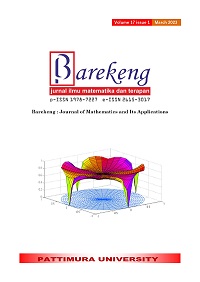ANALYSIS OF SPATIAL EFFECTS ON FACTORS AFFECTING RICE PRODUCTION IN CENTRAL SULAWESI USING GEOGRAPHICALLY WEIGHTED PANEL REGRESSION
Abstract
Fulfillment of rice stock in Indonesia to always be distributed based on demand in the community is certainly closely related to the results of rice production. The results of rice production in various regions of Indonesia are very different. This difference can of course be influenced by geographic location or spatial effects between regions. Central Sulawesi, which is one of the provinces with a large population compared to other provinces on the island of sulwesi, has a responsibility to meet the needs of its community, so it is necessary to take into account and increase the production of rice by relying on production in the province.Modeling of rice production that has spatial effects or heterogeneity between regions is needed as an analytical tool because if the modeling ignores spatial effects and generalizes the model, the modeling predictions will be biased. So we need an analytical model that can accommodate the problem of spatial effects using Geographically Weighted Panel Regression. The purpose of this study was to determine the factors that can affect rice production in central sulawesi. The data used comes from BPS Central Sulawesi province from 2014-2020. This study focus to the spatial effect factors that are considered to be able to affect the rice production production in Central Sulawesi. Tthe results of the study there area 8 districts/cities which are affected by land area, and 4 districts/cities are affected by land area and harvested are.
Downloads
References
D. T. Utari, T. Yuliana, and A. P. Hendradewa, “A Panel Data Analysis of Rice Production in Ngawi Regency, East Java,” in Proceedings of the 2nd International Seminar on Science and Technology (ISSTEC), 2020, vol. 474, no. Isstec 2019, pp. 212–217, doi: 10.2991/assehr.k.201010.031.
N. F. Gamayanti and J. Junaidi, “Pemodelan Hasil Produksi Padi Di Provinsi Sulawesi Tengah Menggunakan Fixed Effect Model (Fem),” BAREKENG J. Ilmu Mat. dan Terap., vol. 15, no. 2, pp. 347–354, 2021, doi: 10.30598/barekengvol15iss2pp347-354.
N. S. Rahayu, “Geogrephically Weighted Panel Regression For Modelling The Percentage of Poor People in Jawa Tengah Province,” pp. 7–32, 2017.
A. Fitrianto and N. F. K. Musakkal, “Panel Data Analysis for Sabah Construction Industries: Choosing the Best Model,” Procedia Econ. Financ., vol. 35, no. October 2015, pp. 241–248, 2016, doi: 10.1016/s2212-5671(16)00030-7.
rizka zulfikar, “Estimation Model And Selection Method Of Panel Data Regression : An Overview Of Common Effect, Fixed Effect, And Random Effect Model,” 2018, doi: 10.31227/osf.io/9qe2b.
D. C. Wati, D. A. Azka, and H. Utami, “The Model of Per-Capita Expenditure Figures in Sumatera Selatan uses a Geographically Weighted Panel Regression,” Indones. J. Stat. Its Appl., vol. 5, no. 1, pp. 61–74, 2021, doi: 10.29244/ijsa.v5i1p61-74.
O. L. Olvera and B. D. Zumbo, “Heteroskedasticity in Multiple Regression Analysis: What it is, How to Detect it and How to Solve it with Applications in R and SPSS [Heteroscedasticidad en análisis de regresión múltiple: qué es, cómo detectarlo y cómo resolverlo con aplicaciones en R y,” Pract. Assessment, Res. Eval., vol. 24, no. 1, 2019.
C. H. Lin and T. H. Wen, “Using geographically weighted regression (GWR) to explorespatial varying relationships of immature mosquitoes andhuman densities with the incidence of dengue,” Int. J. Environ. Res. Public Health, vol. 8, no. 7, pp. 2798–2815, 2011, doi: 10.3390/ijerph8072798.
P. Harris, C. Brunsdon, and A. S. Fotheringham, “Links, comparisons and extensions of the geographically weighted regression model when used as a spatial predictor,” Stoch. Environ. Res. Risk Assess., vol. 25, no. 2, pp. 123–138, 2011, doi: 10.1007/s00477-010-0444-6.
F. Bruna and D. Yu, “Geographically weighted panel regression,” XI Congr. Galego Estatica e Investig. Oper., 2013, [Online]. Available: https://old.reunionesdeestudiosregionales.org/Santiago2016/htdocs/pdf/p1763.pdf.
J. Mummolo, “Improving the Interpretation of Fixed Effects Regression Results*,” vol. 6, no. 4, pp. 829–835, 2018, doi: 10.1017/psrm.2017.44.
S. Martha, Y. Yundari, S. W. Rizki, and R. Tamtama, “Penerapan Metode Geographically Weighted Panel Regression (Gwpr) Pada Kasus Kemiskinan Di Indonesia,” BAREKENG J. Ilmu Mat. dan Terap., vol. 15, no. 2, pp. 241–248, 2021, doi: 10.30598/barekengvol15iss2pp241-248.
R. Cai, D. Yu, and M. Oppenheimer, “Estimating the spatially varying responses of corn yields to weather variations using geographically weighted panel regression,” J. Agric. Resour. Econ., vol. 39, no. 2, pp. 230–252, 2014.
S. M. Meutuah, “Pemodelan Fixed Effect Geographically Weighted Panel Regression Untuk Indeks Pemodelan Fixed Effect Geographically Weighted Panel Regression Untuk Indeks,” vol. 6, pp. 241–250, 2017.
S. badan pusat, “BPS Prov Sulawesi Tengah.” https://sulteng.bps.go.id/statictable/2017/12/21/664/luas-areal-dan-produksi-tanaman-perkebunan-rakyat-menurut-jenis-komoditi-dan-kabupaten-kota-2016-.html.
Copyright (c) 2023 Nurul Fiskia Gamayanti, Junaidi Junaidi, Fadjryani Fadjryani, Nur'eni Nur'eni

This work is licensed under a Creative Commons Attribution-ShareAlike 4.0 International License.
Authors who publish with this Journal agree to the following terms:
- Author retain copyright and grant the journal right of first publication with the work simultaneously licensed under a creative commons attribution license that allow others to share the work within an acknowledgement of the work’s authorship and initial publication of this journal.
- Authors are able to enter into separate, additional contractual arrangement for the non-exclusive distribution of the journal’s published version of the work (e.g. acknowledgement of its initial publication in this journal).
- Authors are permitted and encouraged to post their work online (e.g. in institutional repositories or on their websites) prior to and during the submission process, as it can lead to productive exchanges, as well as earlier and greater citation of published works.






1.gif)



